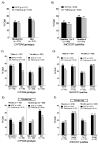Association of nicotine metabolite ratio and CYP2A6 genotype with smoking cessation treatment in African-American light smokers
- PMID: 19279561
- PMCID: PMC3698861
- DOI: 10.1038/clpt.2009.19
Association of nicotine metabolite ratio and CYP2A6 genotype with smoking cessation treatment in African-American light smokers
Abstract
Cytochrome P450 2A6 (CYP2A6) is the main nicotine (NIC)-metabolizing enzyme in humans. We investigated the relationships between CYP2A6 genotype, baseline plasma trans- 3'-hydroxycotinine/cotinine (3HC/COT) (a phenotypic marker of CYP2A6 activity), and smoking behavior in African-American light smokers. Cigarette consumption, age of initiation, and dependence scores did not differ among 3HC/COT quartiles or CYP2A6 genotype groups. Slow metabolizers (SMs; both genetic and phenotypic) had significantly higher plasma NIC levels, suggesting that cigarette consumption was not reduced to adjust for slower rates of NIC metabolism. Individuals in the slowest 3HC/COT quartile had higher quitting rates with both placebo and NIC gum treatments (odds ratio 1.85, 95% confidence interval (CI) 1.08-3.16, P = 0.03). Similarly, the slowest CYP2A6 genotype group had higher quitting rates, although this trend did not reach significance (odds ratio 1.61, 95% CI 0.95-2.72, P = 0.08). The determination of the 3HC/COT ratio, and possibly CYP2A6 genotype, may be useful in the future for personalizing the choice of smoking cessation treatment in African-American light smokers.
Figures




References
-
- Kandel DB, Chen K. Extent of smoking and nicotine dependence in the United States: 1991-1993. Nicotine & Tobacco Research. 2000;2(3):263–274. - PubMed
-
- Centers for Disease Control and Prevention Smoking Cessation During Previous Year Among Adults -- United States, 1990 and 1991. Morbidity and Mortality Weekly Report. 1993:504–507. - PubMed
-
- Centers for Disease Control and Prevention . In: Tobacco use among U.S. racial/ethnic minority groups — African-Americans, American-Indians and Alaska Natives, Asian-Americans and Pacific Islanders, and Hispanics: a report of the Surgeon General. Department of Health and Human Services, editor. Atlanta: 1998. - PubMed
-
- Haiman CA, Stram DO, Wilkens LR, Pike MC, Kolonel LN, Henderson BE, et al. Ethnic and Racial Differences in the Smoking-Related Risk of Lung Cancer. N Engl J Med. 2006;354(4):333–342. - PubMed
Publication types
MeSH terms
Substances
Grants and funding
- K07 CA090334/CA/NCI NIH HHS/United States
- R01 DA002277/DA/NIDA NIH HHS/United States
- CA90334/CA/NCI NIH HHS/United States
- 86471/CAPMC/ CIHR/Canada
- P30 DA012393/DA/NIDA NIH HHS/United States
- R37 DA002277/DA/NIDA NIH HHS/United States
- MOP86471/PHS HHS/United States
- CA91912/CA/NCI NIH HHS/United States
- DA020830/DA/NIDA NIH HHS/United States
- U01 DA020830/DA/NIDA NIH HHS/United States
- R01 CA091912/CA/NCI NIH HHS/United States
- DA02277/DA/NIDA NIH HHS/United States
- DA12393/DA/NIDA NIH HHS/United States
LinkOut - more resources
Full Text Sources
Other Literature Sources
Medical
Molecular Biology Databases
Miscellaneous

